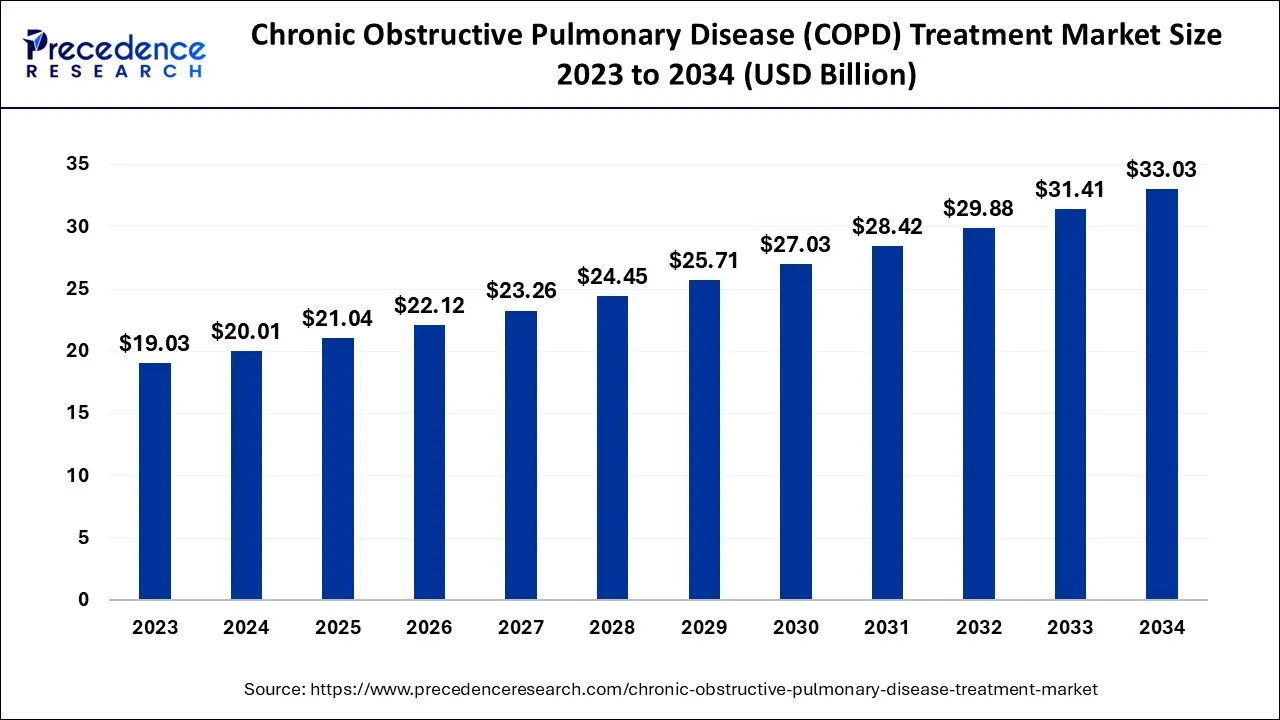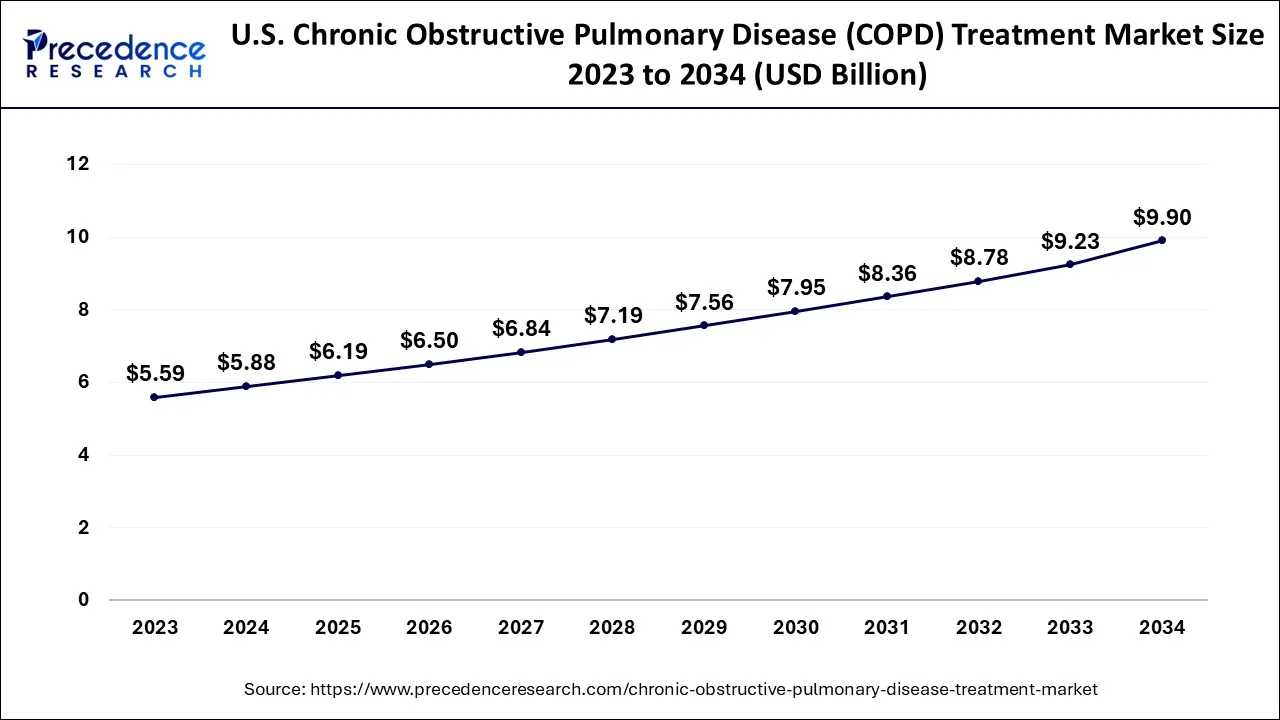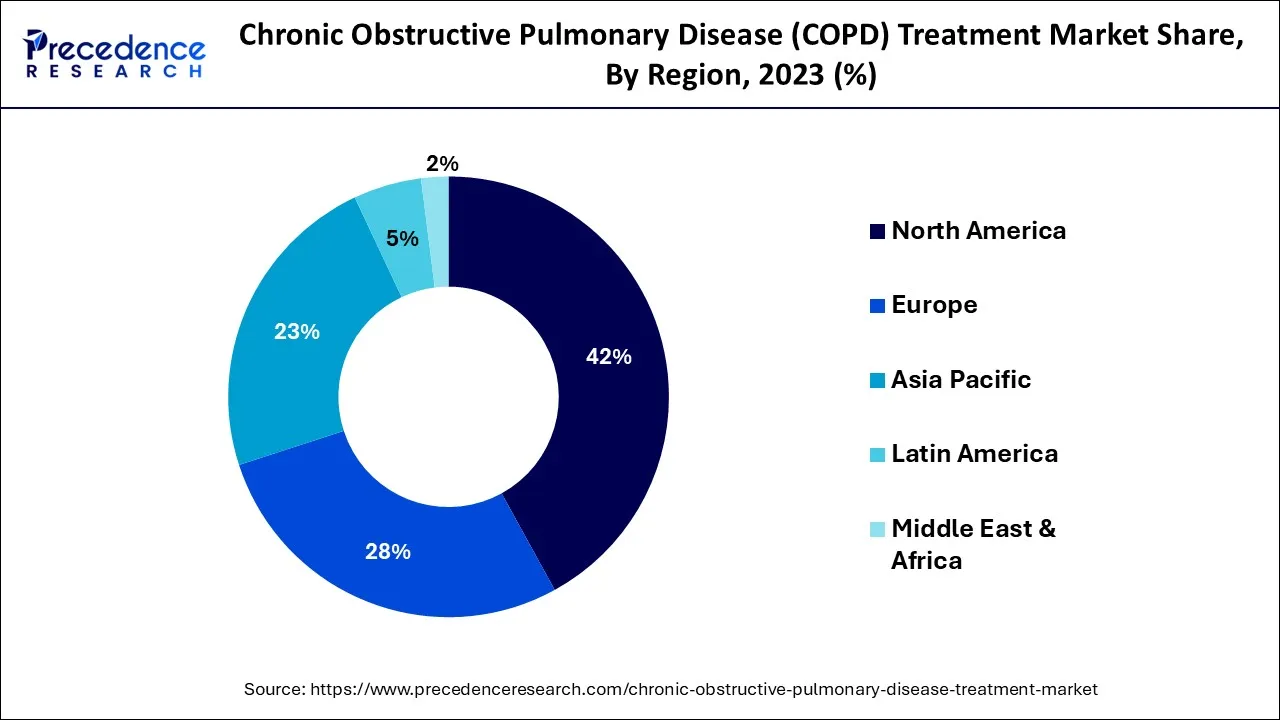February 2025
The global chronic obstructive pulmonary disease (COPD) treatment market size accounted for USD 20.01 billion in 2024, grew to USD 21.04 billion in 2025, and is expected to be worth around USD 33.03 billion by 2034, poised to grow at a CAGR of 5.14% between 2024 and 2034. The North America chronic obstructive pulmonary disease (COPD) treatment market size is predicted to increase from USD 8.40 billion in 2024 and is estimated to grow at the fastest CAGR of 5.26% during the forecast year.
The global chronic obstructive pulmonary disease (COPD) treatment market size is expected to be valued at USD 20.01 billion in 2024 and is anticipated to reach around USD 33.03 billion by 2034, expanding at a CAGR of 5.14% over the forecast period from 2024 to 2034.

The U.S. chronic obstructive pulmonary disease (COPD) treatment market size is exhibited at USD 5.88 billion in 2024 and is projected to be worth around USD 9.90 billion by 2034, growing at a CAGR of 5.34% from 2024 to 2034.

In 2023, North America accounted for the largest market share at around 42%. The region’s growth is due to the high prevalence of COPD, advanced healthcare infrastructure, leading pharmaceutical companies, and a favorable regulatory environment. COPD is a leading cause of death and disability in the United States, with an estimated 16 million adults diagnosed with the disease. This high prevalence of COPD is driving the demand for COPD treatment in the region.
Additionally, North America has a well-established healthcare system that supports diagnosing, treating, and managing COPD. The region has a large network of hospitals, clinics, and pharmacies that provide access to COPD treatments, contributing to the market’s growth.

Moreover, North America is home to some of the world's leading pharmaceutical companies, such as GlaxoSmithKline, AstraZeneca, and Boehringer Ingelheim, which have a strong presence in the COPD treatment market. The presence of these companies has led to the development of innovative drugs and therapies, contributing to the market’s growth. Furthermore, the regulatory environment in North America is favorable for the growth of the COPD treatment market.
The US FDA has approved several drugs for treating COPD, providing patients access to effective treatment options. Furthermore, the North American COPD treatment market presents significant growth opportunities for pharmaceutical companies and stakeholders.
Market Overview
The chronic obstructive pulmonary disease (COPD) treatment market refers to the market for products and services to treat COPD, a chronic respiratory disease that causes breathing difficulties, coughing, wheezing, and other symptoms. COPD is a progressive disease caused by long-term exposure to irritants like cigarette smoke, air pollution, and dust, and it is characterized by the obstruction of airflow from the lungs. COPD treatments include various products and services, including medications, inhalers, nebulizers, oxygen therapy equipment, and pulmonary rehabilitation programs. These products and services help patients manage their symptoms, improve their lung function, and maintain their overall quality of life.
The COPD treatment market is growing rapidly as the prevalence of COPD continues to increase worldwide, particularly in developing countries where smoking rates are high and air pollution is a significant problem.
| Report Coverage | Details |
| Market Size in 2024 | USD 20.01 Billion |
| Market Size by 2034 | USD 33.03 Billion |
| Growth Rate from 2024 to 2034 | CAGR of 5.14% |
| Largest Market | North America |
| Base Year | 2023 |
| Forecast Period | 2024 to 2034 |
| Segments Covered | By Drug Class, By Type, and By Distribution Channel |
| Regions Covered | North America, Europe, Asia-Pacific, Latin America and Middle East & Africa |
Increasing prevalence of COPD
COPD is a chronic respiratory disease that causes breathing difficulties, coughing, wheezing, and other symptoms. The disease is often caused by long-term exposure to irritants like cigarette smoke, air pollution, and dust. According to the World Health Organization (WHO), COPD is the third leading cause of death worldwide and is projected to become the fifth leading cause of death by 2030.
The prevalence of COPD is increasing worldwide, particularly in developing countries with high smoking rates, and air pollution is a significant problem. The increase in COPD prevalence is due to several factors, including the aging population, urbanization, and lifestyle changes. As people age, they are more susceptible to developing COPD.
As more people move to urban areas, they are exposed to higher levels of air pollution, which contribute to the development of COPD. In addition, lifestyle changes such as increased smoking rates and decreased physical activity levels also contribute to the rise in COPD prevalence. As the prevalence of COPD continues to increase, the demand for COPD treatment is also growing. This drives the growth of the COPD treatment market as more people seek treatment for their symptoms. Pharmaceutical companies are developing new medications and inhalers to improve the effectiveness of COPD treatment.
Medical device companies are developing new nebulizers and oxygen therapy equipment to improve patient outcomes. Therefore, the increasing prevalence of COPD is a significant driver of the COPD treatment market.
High cost of treatment
COPD is a chronic disease that often requires long-term care and specialized treatment, which is expensive. In addition, many COPD patients also have other comorbidities, which further increase healthcare costs. The cost of COPD treatment is a major barrier to access for many patients, particularly in developing countries with high healthcare costs and limited insurance coverage. This leads to underdiagnosis and undertreatment of the disease, negatively impacting patient outcomes and quality of life.
In addition, the high cost of COPD treatment also impacts healthcare systems and payers, as they struggle to cover the cost of treatment for large numbers of COPD patients. This leads to cost containment measures, such as restricting access to medications and medical devices, further limiting patient access to care. Therefore, the high cost of COPD treatment is a significant restraint on the growth of the COPD treatment market. Addressing this issue is vital for improving patient outcomes and expanding access to care. This involves reducing the cost of medications and medical devices, increasing insurance coverage for COPD treatment, and improving healthcare efficiency to reduce overall healthcare costs.
Development of innovative therapies and treatment approaches
Most COPD treatments focus on managing symptoms and slowing the progression of the disease. However, there is a significant need for new and innovative therapies that provides better outcomes for patients and improve their quality of life. In recent years, research and development have focused on new COPD treatments, including biologics, gene therapies, and other novel approaches. These therapies potentially address the underlying causes of COPD and provide patients with more effective and targeted treatment options.
In addition, technological advances are also creating new opportunities for COPD treatment. For instance, wearable devices and remote monitoring systems help patients and healthcare providers better manage symptoms and track disease progression. Therefore, the development of innovative therapies and treatment approaches is a significant opportunity for the COPD treatment market, and investing in research and development in this area is expected to drive growth and improve patient outcomes in the years to come.
Based on drug class, the chronic obstructive pulmonary disease (COPD) treatment Market is segmented into Combination Therapy, Bronchodilators, Corticosteroids, Phosphodiester Type 4 Inhibitors, Mucokinetics, and Others. In 2023, combination therapy accounted highest market share. Combination therapy involves using multiple medications, such as bronchodilators and corticosteroids, to manage COPD symptoms and improve lung function. Combination therapy is becoming increasingly popular as it allows for more effective management of COPD symptoms than monotherapy, which involves using a single medication.
Many patients also prefer combination therapy, which reduces the need for multiple medications and simplifies treatment regimens. In addition, some combination therapies are available in a single inhaler device, which improves patient adherence and makes treatment more convenient. The combination therapy segment of the COPD treatment market is expected to experience strong growth in the coming years, driven by factors such as the increasing prevalence of COPD, growing awareness of the benefits of combination therapy, and the development of new and more effective combination therapies.
Based on type, the market is segmented into chronic bronchitis and emphysema. In 2023, chronic bronchitis accounted for the highest market share. The prevalence of chronic bronchitis is increasing globally, particularly among the aging population. Chronic bronchitis is a progressive disease that worsens over time and is typically diagnosed in people over 40. As the population ages, chronic bronchitis is expected to rise, driving growth in the chronic bronchitis segment of the COPD treatment market.
In addition, there is growing awareness of the disease among patients and healthcare providers, leading to earlier diagnosis and treatment. This is particularly important for chronic bronchitis, which often is mistaken for a simple cold or cough in its early stages. Earlier diagnosis and treatment help slow the disease's progression and improve patient outcomes.
Moreover, there is ongoing research and development in the field of COPD treatment, focusing on developing new and more effective medications and therapies for chronic bronchitis. For instance, new bronchodilators and anti-inflammatory medications are being developed that target specific pathways involved in the development and progression of the disease. Furthermore, lifestyle changes such as smoking cessation and avoiding environmental irritants such as air pollution are also expected to drive growth in the Chronic Bronchitis segment of the COPD treatment market. These changes help manage symptoms and slow the progression of the disease, reducing the need for more aggressive treatments over time.
Based on distribution channel, the market is segmented into hospital pharmacies, retail pharmacies, and online pharmacies. In 2023, retail pharmacies accounted for a significant market share. The prevalence of COPD is increasingly leading to an increase in patients requiring medications to manage their symptoms, and this drives the demand for COPD medications from retail pharmacies. In addition, the convenience of filling prescriptions close to home is a significant factor contributing to the growth of the retail pharmacies segment. Patients with COPD often require regular medication refills, and having a retail pharmacy nearby makes it easier to access the needed medications.
Moreover, retail pharmacies increasingly offer personalized services such as medication counseling and education for patients with COPD. This helps patients understand their medication regimens and manage their symptoms more effectively. Furthermore, the retail pharmacy industry is evolving rapidly with the growth of e-commerce and online ordering. Retail pharmacies are adapting to these changes by offering online order and delivery services for medications, further driving growth in this segment. Therefore, the growing prevalence of COPD, the convenience of filling prescriptions close to home, the availability of personalized services, and the evolution of the retail pharmacy industry all contribute to the growth of the Retail Pharmacies segment in the COPD treatment market.
Segments Covered in the Report
By Drug Class
By Type
By Distribution Channel
By Geography
For inquiries regarding discounts, bulk purchases, or customization requests, please contact us at sales@precedenceresearch.com
No cookie-cutter, only authentic analysis – take the 1st step to become a Precedence Research client
February 2025
May 2024
March 2025
January 2025